Renewable Energy CFD Training Package, Beginners, 10 Practical Exercises
$189.00 $94.50 Student Discount
This training package, including 10 different practical exercises for BEGINNER users, insets Computational Fluid Dynamics (CFD) methods and materials for designing, simulating, and dissecting applied and Renewable engineering CFD projects, with practical experiments using ANSYS Fluent software.
Click on Add To Cart and obtain the Geometry file, Mesh file, and a Comprehensive ANSYS Fluent Training Video.To Order Your Project or benefit from a CFD consultation, contact our experts via email (info@mr-cfd.com), online support tab, or WhatsApp at +44 7443 197273.
There are some Free Products to check our service quality.
If you want the training video in another language instead of English, ask it via info@mr-cfd.com after you buy the product.
Description
Renewable Energy – ANSYS Fluent Training Package, 10 Practical Exercises and CFD Simulation for Beginner Users
Renewable Energy CFD Training Package, including 10 different practical exercises for BEGINNER users, insets Computational Fluid Dynamics (CFD) methods and materials for designing, simulating, and dissecting applied and Renewable engineering CFD projects, with practical experiments using ANSYS Fluent software.
On successful completion of this course you will be able to:
- Assemble and evaluate the different components of the CFD process in the renewable engineering field, since we simulate place a wide range of various CFD projects in this training package.
- Explain the suitable CFD methods for many renewable energy CFD simulations and how to solve them computationally,
- Compare and contrast various methods for simulating turbulent flows applicable to civil and mechanical engineering, especially offshore, solar, and wind renewable energy applications such as wind turbines, tidal turbines, solar collectors, and so on.
- Set up simulations and evaluate a practical problem using a commercial CFD package (ANSYS Fluent),
- Design CFD modeling studies of renewable energy devices.
Training Package
Lots of projects in the Renewable Energy engineering field are simulated by ANSYS Fluent software using CFD methods.
Study number 1 deals with heat transfer within a pipe carrying water flow in a parabolic solar collector. In fact, in the present model, there is a water flow in a pipe that has been exposed to solar radiation. Behind the tube, there is a parabolic plate as the solar radiation absorber plate, which is responsible for absorbing the solar radiation energy and then reflecting it.
In simulation number 2, we model a solar chimney. The lower part of the chimney is a plate to absorb the heat of the solar radiation, which we assume it as a constant temperature in the present simulation. The ground floor below this chimney also has a constant temperature.
In project number 3, the airflow inside a dry cooling tower (HELLER) is simulated and analyzed. A dry cooling tower is used as a means of indirect heat transfer between the working fluid (water) and the coolant (air). In a thermal plant, the working fluid (water) exits the condensers and then is pumped into a ring of heat exchangers. These heat exchangers are air-cooled, which means that they are cooled by natural air suction caused by a temperature difference between the inside and the outside of the cooling tower. In practical exercise number 4, the transient simulation of the Heller cooling tower is investigated. Heller cooling tower is an indirect heat exchanging mechanism in which airflow over the water stream and heat exchange process density decreases, and an upward flow is generated. In the present work, an ideal gas model is used for air density modeling.
Study number 5 deals with the airflow on the HAWT blades so the purpose of the problem is to study the distribution of velocity and pressure on the surface of the blades and on their body. There are three areas around the blades for airflow. There is an area around the blades, an area in the front of the blades, and an area behind the blades. Problem number 6 is simulating the HVAC inside the room considering a solar chimney. The present model consists of two main parts, including the interior of the room and a sloping solar chimney on the ceiling of the room. The solar chimney consists of glass plates on its side surfaces that are in contact with the environment and, as a transparent medium, receive the solar energy and also have a plate on its back as a heat-absorbing surface.
In project number 7, heat transfer in a conical solar collector containing water fluid is simulated and analyzed. The cubic computational domain consists of an inlet (velocity inlet type, 1m/s) and a pressure outlet. The conical collector consists of an inlet (mass-flow type, 0.0116 Kg/s) and a pressure outlet. In practical exercise number 8, using PCM encapsulated in a water tank solar heater has been investigated with different considerations, including the effect of melting and freezing temperature of PCM material, the effect of PCM material volume, and a comparison with no PCM material. The PCM inner wall is considered a wall with a temperature condition of 603.3 K and a thickness of 0.0015 m. For the outer wall of this space, the wall boundary condition with the adiabatic condition is used.
In project number 9, steady airflow in the presence of an H-type wind turbine is investigated. Nowadays, turbines are a reliable, clean energy source, which generates electricity using the induced rotation by wind flow. However, turbine wind farms face challenging issues such as low efficiency at lower diameters for horizontal axis wind turbines (HAWT), disruption of natural view of valleys, and low wind conditions. Finally, practical exercise number 10 is going to simulate an airflow field adjacent to the Liam F1 wind turbine as the last product of this training package. The geometry included a rotary zone for the turbine walls and a stationary zone for the rest of the domain. The inlet is considered 3 m/s and the turbine zone is rotating with 300 RPM.
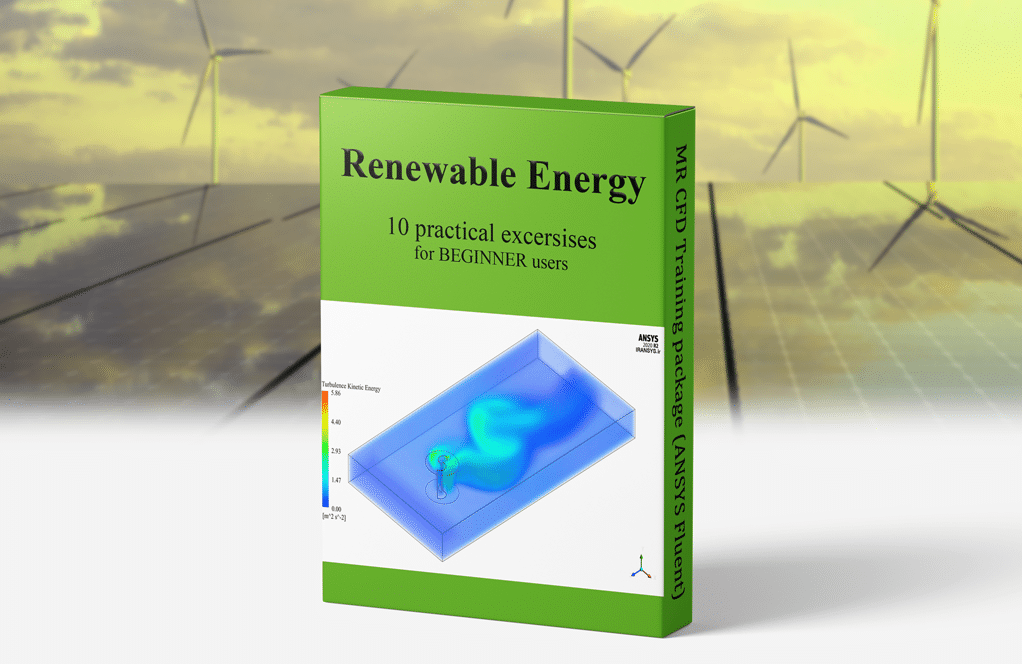








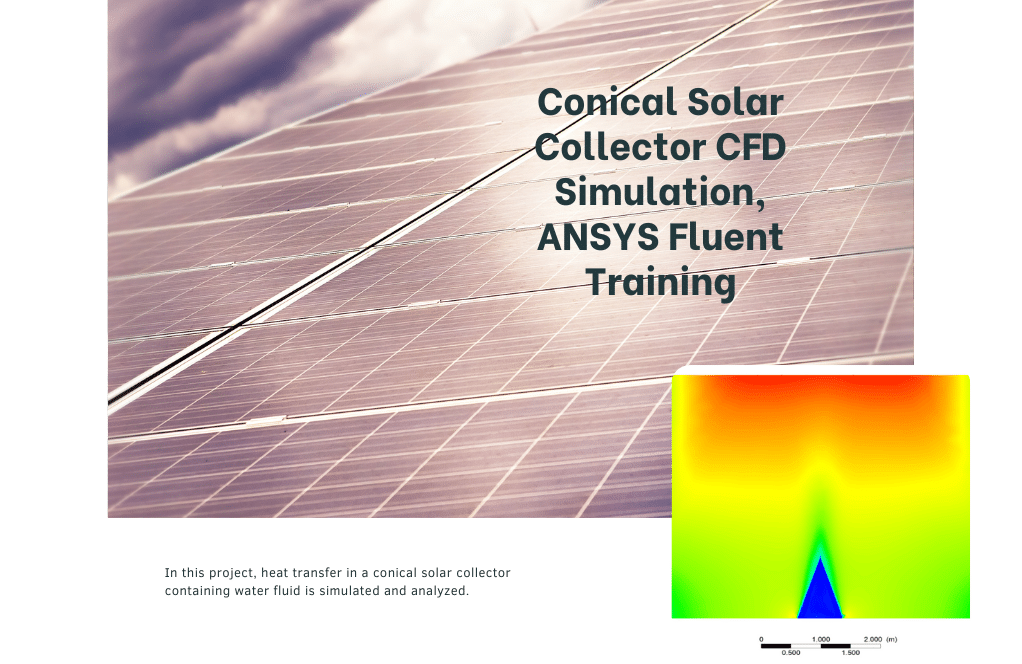
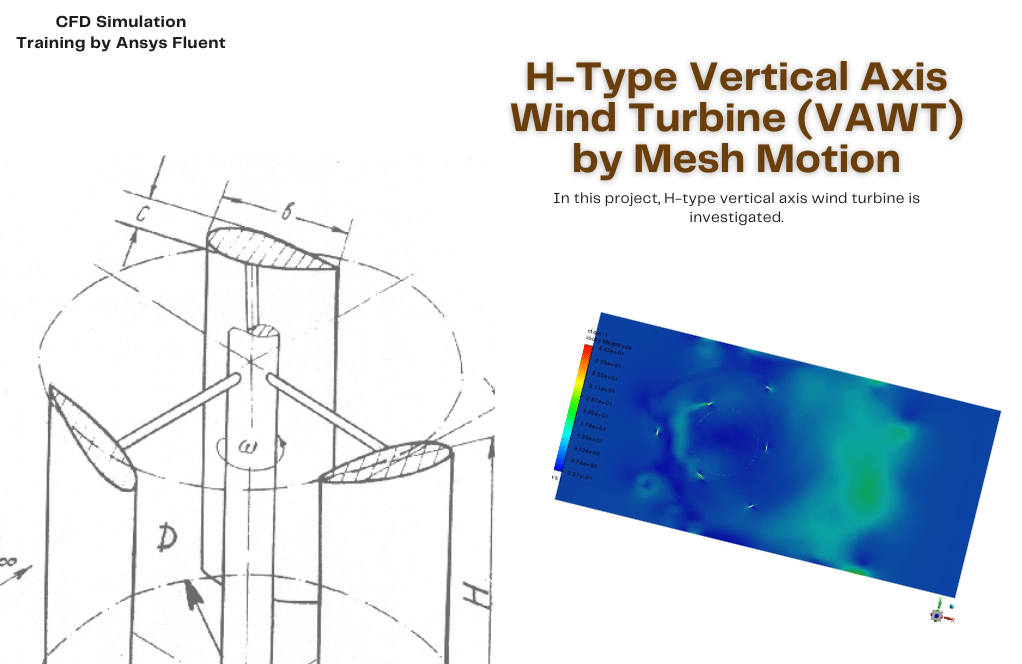
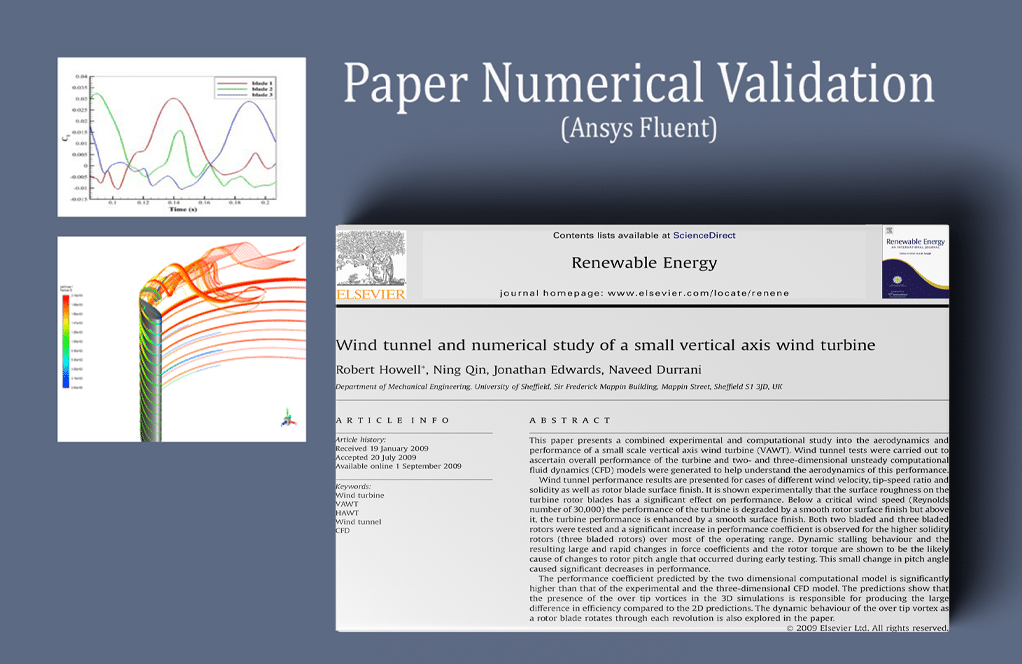

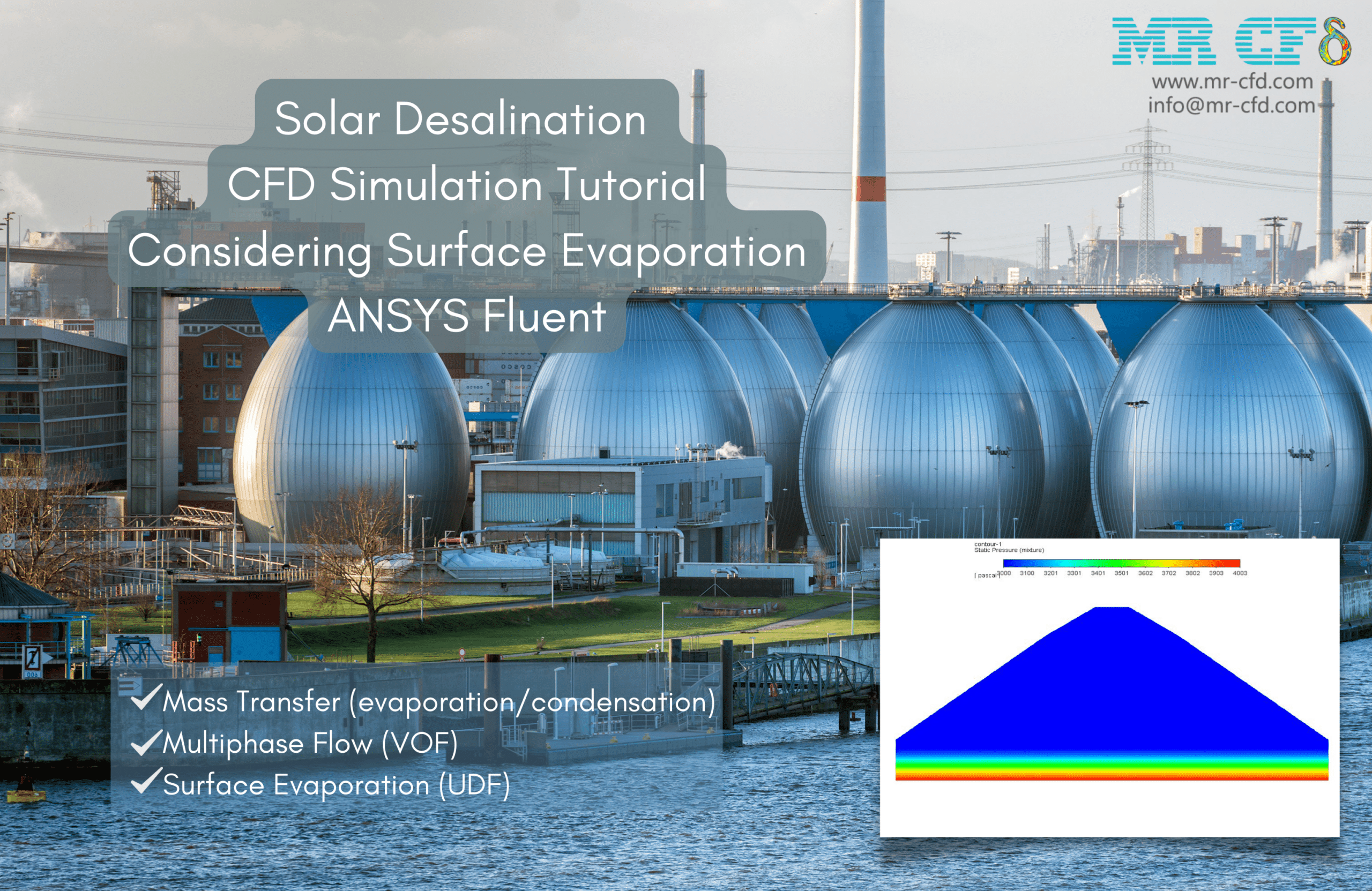
Aurelie Daugherty –
I recently went through the ‘Renewable Energy CFD Training Package for Beginners’ and was impressed by the wide array of exercises. The topics covered were very diverse within the renewable energy sector and provided a hands-on approach to understand the dynamics and physics of the models. Specifically, I found the exercises on solar collectors, cooling towers, and examining different types of wind turbines to be deeply enriching.
MR CFD Support –
Thank you for taking the time to provide your feedback on the ‘Renewable Energy CFD Training Package for Beginners.’ We’re so glad to hear that you found the training to be valuable, diverse, and hands-on. Your highlights on the exercises such as those on solar collectors and wind turbines affirm our dedication to offering comprehensive educational experiences. We appreciate your review!
Annamae Carter –
I was very impressed with the Renewable Energy CFD Training package. Each exercise was detailed and provided in-depth understanding, it’s a perfect way to get your hands dirty with practical examples.
MR CFD Support –
Thank you for the positive feedback on our Renewable Energy CFD Training Package. We’re delighted to hear that you found our practical examples detailed and helpful. It’s always great to see our customers putting new knowledge into practice!
Prof. Andreane Blick PhD –
I recently completed the Renewable Energy CFD Training Package and thoroughly enjoyed each practical exercise. The projects were well constructed, offering a clear insight into various renewable energy applications, and the use of ANSYS Fluent made it easy to implement theory into practice. This experience has undoubtedly enhanced my understanding of CFD in renewable energy scenarios.
MR CFD Support –
We’re thrilled to hear that you had a satisfactory experience with our Renewable Energy CFD Training Package. It’s wonderful that you found the combination of practical exercises and ANSYS Fluent simulation beneficial for your understanding of CFD applications in renewable energy. Thank you for choosing our training package, and we appreciate your positive feedback. If you have any further inquiries or need additional resources, feel free to reach out to us.
Prof. Nikolas Bechtelar DVM –
I purchased the Renewable Energy CFD Training Package, and I must say each exercise was professionally structured. The variety from simulating solar collectors to wind turbines provided a well-rounded experience in renewable energy applications. As someone new to ANSYS Fluent, these guided experiments made the learning curve significantly less intimidating. The inclusion of both beginner and more complex scenarios was particularly beneficial.
MR CFD Support –
We’re thrilled to hear that you are satisfied with our Renewable Energy CFD Training Package! It’s great to know that we were able to support your introduction to ANSYS Fluent effectively. Thank you for your kind words, and we hope that you continue to enjoy your learning journey with us!
Magdalena Waelchi –
I’ve been wanting to deepen my understanding of renewable energy and CFD. This package seems extensive, but I’m curious if there are step-by-step guides for beginners in each of the exercises?
MR CFD Support –
Yes, this training package is designed with beginners in mind. Each practical exercise comes with a step-by-step tutorial that covers all the essentials to guide you seamlessly from setup to solution. There are also detailed explanations on how to interpret the results of each simulation.
Loma Kassulke –
I’m new to CFD and interested in renewable energy. What level of prior knowledge do I need before starting this training package?
MR CFD Support –
The Renewable Energy CFD Training Package is designed for BEGINNER users, meaning you are coming to the right place if you are new to CFD. The only prerequisite is a basic understanding of fluid dynamics principles and prior experience with ANSYS Fluent, while prior experience with environmental engineering or renewable energy principles could be beneficial, it’s not strictly necessary as the exercises are meant to walk you through all the necessary steps.
Cyrus Schoen –
This course was a fantastic launch pad for me into the world of CFD applications in renewable energy! The mix of projects like solar collectors and wind turbines really helped solidify my understanding of the different challenges in this industry. I could apply the theory and see real-world applications through these exercises. Keep up the great work!
MR CFD Support –
Thank you for your positive feedback! We’re thrilled to hear that our Renewable Energy CFD Training Package has provided you with a comprehensive understanding of CFD in the renewable energy sector. We’re glad that the practical exercises have been useful for you to see the real-world applications of the theory you’ve learned. Your enthusiasm for continuing your learning journey in CFD is inspiring! If you have any further questions or need assistance with more advanced simulations, please don’t hesitate to reach out.
Arno Rosenbaum –
Such a comprehensive collection of practical exercises really distilled the complexities of CFD in the renewable energy sector down to bite-sized pieces for a beginner like me. Learning to simulate airflow, understanding heat transfer in various systems, and analyzing wind and solar energy applications was made engaging and informative with this package.
MR CFD Support –
We are thrilled to know that our Renewable Energy CFD Training Package meet your learning needs! Your insight as a beginner is valuable to us, and we are happy that our step-by-step exercises helped make complex CFD concepts more digestible. Thank you for your positive feedback, and we wish you the best in your ongoing exploration of renewable energy systems with CFD.
Mrs. Lucinda Casper MD –
I recently completed the Renewable Energy CFD Training Package for Beginners with 10 Practical Exercises using ANSYS Fluent, and I’m genuinely impressed! Not only was the presentation of theories and principles crystal clear, but the step-by-step practical exercises made it easy to apply what I’ve learned to real-world scenarios. Coming from a novice background in CFD, this course has elevated my understanding and confidence in tackling renewable energy-related simulation projects. The depth and variety of practical exercises left me with a strong foundation and inspiration to further explore this exciting field. This training package is a game-changer for anyone looking to get started in renewable energy engineering!
MR CFD Support –
Thank you so much for your kind review! We’re thrilled to hear that the Renewable Energy CFD Training Package has served as a solid foundation for your understanding of CFD applications in renewable energy. It’s inspiring to know that our course has helped you gain confidence and sparked further interest in renewable energy simulations. If you ever have any questions or need assistance as you continue exploring this dynamic field, please know that our team is always here to support your learning journey. Happy simulating!
Ova Barrows V –
I’ve thoroughly enjoyed the simulations in the Renewable Energy CFD training package. The step-by-step instructions helped me enormously to understand the renewable energy elements in each simulation. The variety of projects, from the helix-driven Liam F1 turbine to the warmth of the solar collector, is exceptionally well designed. I believe the hands-on experience will be invaluable for my future projects in renewable energy applications.
MR CFD Support –
We’re thrilled to hear that our Renewable Energy CFD Training Package has been so beneficial for you! It’s great to know that our detailed tutorials and the variety of projects provided have enriched your understanding of renewable energy systems. Your feedback is much appreciated, and we wish you the best in your future renewable energy endeavors. Thank you for choosing our program!
Dr. Pablo Gerlach –
These CFD simulations opened my eyes to the varied applications of renewable energy! Completing each exercise boosted my skills, and it was particularly enlightening to see how solar and wind systems can be optimized. Viewing the detailed simulations for each unique setup, like the dry cooling tower’s airflow analysis and the HAWT blades’ velocity distribution, made learning quite impactful. Such a comprehensive package for beginners is invaluable!
MR CFD Support –
We sincerely appreciate the time you’ve invested in our Renewable Energy CFD Training Package and thank you for your incredibly kind words. It’s such a joy to hear how much value and insight you’ve gained from these exercises, and we’re thrilled you’ve found our step-by-step simulations enlightening for understanding renewable energy applications. Your satisfaction as a beginner user truly warms our hearts, and we look forward to assisting you with any further learning endeavors in the field of CFD!
Trisha Smitham –
I am fascinated with study number 8 on PCM in a water tank solar heater. Could you provide more insight on how the PCM’s melting and freezing temperatures affect the overall system efficiency in this simulation?
MR CFD Support –
The PCM’s melting and freezing temperatures play a crucial role in its ability to store and release heat. During the day, when the temperature surpasses the melting point, the PCM absorbs a significant amount of heat, thus preventing excessive temperature increase. Conversely, at night or when the temperature drops below the freezing point, the PCM releases the stored heat, maintaining the temperature of the water tank. These characteristics of PCM can enhance the system’s efficiency by mitigating temperature fluctuations and ensuring a more stable heat supply.